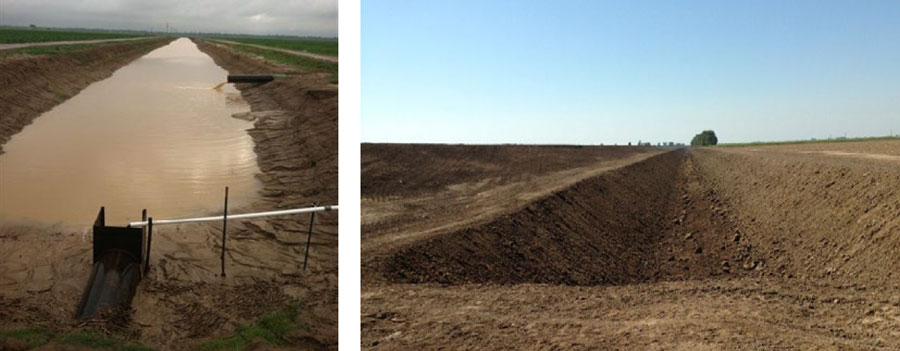Tailwater Recovery and On-Farm Storage Reservoir: System Overview
Tailwater recovery (TWR) systems are a combination of financially assisted (by Natural Resources Conservation Service) conservation practices aimed at collecting runoff and storing that water for irrigation. As freshwater resources for irrigation decline, this surface water storage structure is a viable option for capturing and recycling precipitation and irrigation runoff.


Potential practices in TWR systems (NRCS practice codes):
- Irrigation reservoir (436)
- Tailwater recovery (437)
- Critical area stabilization (342)
- Irrigation water conveyance (430)
- Irrigation water management (449)
- Precision land forming (462)
- Pumping plant water control (533)
- Access road (560)
- Water control structures (587)
- Dikes (356)
In-Field TWR System Practices
Precision land forming (land leveling, land grading) is used to direct water to one end of the field by grading the field with a slope of 0–0.1 inches per 100 feet run for rice and 0.1–0.2 inches per 100 feet run for cotton, corn, and soybeans.

Edge-of-Field TWR System Practices
Water control structures (riser or slotted board pipes) are used to convey water from the field through the dikes (pads) on the perimeter of the field and into the TWR ditch. These pipes allow fields to be flooded by inserting boards.

TWR Ditches
TWR ditches are used to store water runoff from the field until it can be irrigated or re-lifted into the on-farm storage reservoir (OFS). TWR ditches are fit into the landscape, reducing the amount of acreage taken out of production.

Pumping plants are used to re-lift water from the TWR ditch to the OFS, as well as irrigate water.

On-Farm Storage Reservoirs
On-farm storage reservoirs are used as additional storage areas. They are usually much larger than TWR ditches. OFS are installed near TWR ditches on less productive land or made from vacant catfish ponds.

TWR System Design Examples
TWR systems should be designed to remove as little production land as possible. TWR systems can be used to store water not only for irrigation, but also for livestock, fish, and/or wildlife. Below are some examples of how producers in the Mississippi Delta region are fitting TWR systems into their landscapes.


Farm 1. Re-land formed fields with a TWR ditch along the tree line and an OFS reservoir replacing a small field in the trees.


Farm 2. Re-land formed fields and expanded an existing ditch into a large TWR ditch.


Farm 3. Re-land formed fields, added a TWR ditch, and used existing retired catfish ponds as OFS reservoirs.
For more information
Consult your county USDA Natural Resources Conservation Service agent for more details on conservation practices.
Publication 3125 (POD-09-24)
By Austin Omer, PhD, former Extension Associate, and Beth Baker, PhD, Associate Extension Professor, Wildlife, Fisheries, and Aquaculture.
The Mississippi State University Extension Service is working to ensure all web content is accessible to all users. If you need assistance accessing any of our content, please email the webteam or call 662-325-2262.




